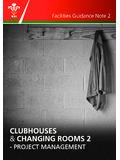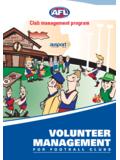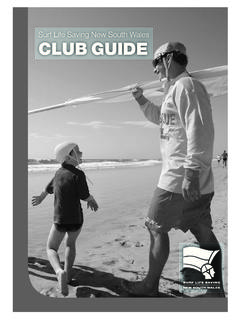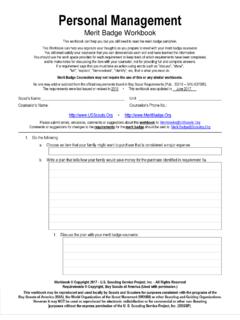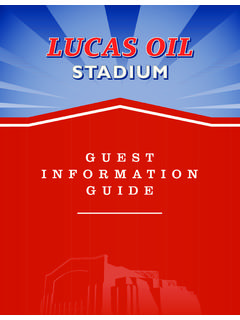Transcription of Club Development Plan - Welsh Rugby Union
1 guide to Writing a club Development Plan The most effective and efficient road to improvement is planning. By formulating a club Development Plan including short, medium and long term aims and objectives you will be able to prioritise club projects and associated funding and hence achieve your goals. Producing a Development plan is often perceived as an onerous task taking up valuable volunteer time. It should not be seen in this way. Rather it should be seen as a list of to do s which will ultimately save time and effort in progressing the club . A small working party of members with knowledge, experience, drive and enthusiasm should lead the Development programme.
2 A good club Development plan should be based on the club s current position and a realistic long term model (usually three or five years). The plan can incorporate capital build projects, refurbishments, player and volunteer recruitment targets, coach and referee Development , in fact any area of on and off field Rugby that can be improved. Why Plan Identify and prioritising aims and objectives for the future (essential for sustainability). Use club resources more efficiently and effectively. Professional & businesslike approach Be proactive NOT reactive Improved chances of securing external funding.
3 Improved services for members. Attract new members. Succession planning Improve links with local authorities and schools. How to Plan The plan should be based on five simple questions: 1. History Where have we come from? 2. Audit Where are we now? 3. Aims Where do we want to be? 4. Plan How will we get there? 5. Review How will we know we have achieved our targets? 1. History Begin with a brief history of the club . 2. The Audit Before you can begin to plan for the future you need to consider the current position. This can be most easily achieved by conducting a SWOT analysis which identifies strengths, weaknesses, opportunities and threats in six key areas.
4 Legal Constitution, incorporation, CASC, insurance, health & safety, risk assessment, safeguarding, etc Administration Volunteers, committee/management structure, first aid, marketing, promotion, club policies, role descriptions, etc Finance Budget, income & expenditure, accounts, cash flow, fundraising, gift aid, audit, VAT, tax, rates, assets, depreciation, facility hire, etc Facilities Pitch, changing rooms, floodlights, equipment, kit, maintenance, clubhouse, kitchen, bar etc Playing Minis, juniors, youth, seniors, women & girls, coaches, referees, Development & education, recruitment, competition, fixtures, disability, etc Social Community involvement, partnerships, schools, universities, colleges, events, etc Examples of what to consider in each section of the SWOT analysis can be seen below but the list is by no means exhaustive.
5 STRENGTHS Facilities changing rooms and toilets recently refurbished New match lights Pitch quality and availability club reputation Assets Financial situation Sufficient volunteer coaches and referees WEAKNESSES Legal status unincorporated Committee structure No safeguarding officer Not enough first aiders No volunteer role descriptions in place Lack of equipment Training lights require replacing Player numbers decrease in juniors No level 3 coaches Social calendar/hiring of facilities OPPORTUNITIES Catchment area Accessibility Secondary schools FE colleges & universities Public transport Partners & sponsors Funding: community chest Lack of community facilities in village Potential partnerships with other sports or community groups.
6 THREATS Decreasing junior members Players leaving to other sports Other Rugby teams Funding issues Other sports clubs Prejudice 3. The Aims Having analysed where you are, you now need to consider where you want to be and establish your aims for the future. Using the SWOT analysis you should aim to build on the strengths, address the weaknesses, utilise the opportunities and deal with the threats. The aims that you set should be SMART: Specific to your club Measureable how will you know the aim has been met? Agreed between all the committee members, volunteers, players (as appropriate) Realistic achievable in terms of the SWOT analysis, finance, NGB support, etc Timed when you plan to achieve the aims.
7 Examples of aims that you may set: Incorporate and become a CASC Produce Role Descriptions for all Volunteer positions Secure funding to replace training lights 4. The Plan Once you have identified your aims, the plan will set out HOW you will achieve them but first they need to be prioritised usually over a one, three or five year period. How your aims are prioritised may depend on the simplicity of the task or perhaps the financial cost of achievement. Remember, aims must be REALISTIC in terms of timescale and cost. The Plan can be formulated in any number of ways but a simple template is shown below.
8 WHAT What do you want to achieve? HOW How will it be achieved? WHEN When will it be achieved by? WHO Who is going to do it? COST What will it cost in terms of money, time, people, etc? Become incorporated and a CASC Work with WRU finance and club Development on legal status. Make use of all CASC benefits December 2011 club secretary , treasurer and funding officer Meetings. Financial cost of incorporation. Produce role descriptions for all volunteer roles. Use templates available on WRU website to produce individual role descriptions. Distribute the role descriptions and discuss with each volunteer.
9 December 2011 club secretary and volunteer coordinator 3x1hour meetings to formulate descriptions plus 15 minutes with each volunteer. Replace training lights Research funding streams available for floodlights Obtain 3 quotations for work Apply for funding Instruct a contractor September 2012 Funding officer and club treasurer Ball park figure of 40k based on other Rugby club lighting projects. 5. The Review Once the action plan is agreed it is a working document that should be reviewed and updated regularly to ensure progress is being made and targets met. It should be modified to take account of changes in personnel, unforeseen delays, funding issues etc.
10 A report should be made at the monthly committee meeting with regards to progress and to acknowledge the work of the volunteers involved.
